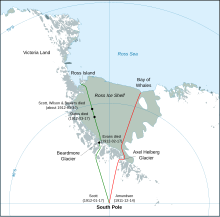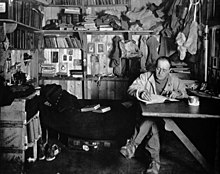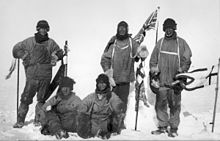Robert Falcon Scott
Robert Falcon Scott | |
|---|---|
 | |
| Born | 6 June 1868 |
| Died | 29 March 1912 (aged 43) |
| Education | Naval cadet programme, HMS Britannia |
| Occupation(s) | Royal Navy officer and Antarctic explorer |
| Spouse | Kathleen Bruce |
| Children | Peter Markham Scott, later Sir Peter Scott |
| Parent(s) | John Edward and Hannah Scott |



Captain Robert Falcon Scott CVO, RN (6 June 1868 – 29 March 1912) was an English Royal Navy officer and explorer who died on an expedition to the South Pole. He is widely known as Scott of the Antarctic, the title of a 1948 movie.
Scott led two expeditions to the Antarctic regions: the Discovery Expedition, 1901–04, and the ill-fated Terra Nova Expedition, 1910–13.[1] Before his appointment to lead the Discovery Expedition, Scott had followed the conventional career of a naval officer in peacetime Victorian Britain, where opportunities for career advancement were keenly sought after by ambitious officers.
It was the chance for personal distinction that led Scott to apply for command of the Discovery.[2] His name became associated with the Antarctic, his field of work for the final twelve years of his life.
Terra Nova Expedition 1910–1913[change | change source]
During this second venture, Scott led a party of five which reached the South Pole on 17 January 1912, only to find that Roald Amundsen's Norwegian expedition had got there first. On the return journey, Scott and his four comrades died from exhaustion, starvation and extreme cold. The tragic fate of his expedition is still remembered throughout the world.
Scott's leadership[change | change source]
After his death, Scott became a British hero. His reputation suffered from several books written later in the 20th century.[3] Still later, Scott's record was reviewed more favourably.[4] The main cause of the failure of the expedition is now said to be the exceptionally adverse weather at the end of the return from the pole.[5]
Scott took ponies, motorised sleds and ordinary sleds, which he and his men pulled. He thought that the number of animals overworked and killed should be held as low as possible and considered his rival Roald Amundsen's approach as cruel.[6] Amundsen, on the other hand, killed dog after dog to feed himself, the men and the rest of the dogs. He did not feel bad about it. The ponies helped travelling part of the way to the pole, but some of them were so stubborn that the expedition members, especially Lawrence Oates, lost much energy that was needed to get back from the pole. The motorised sleds (which worked well at the start) eventually froze up. The dogs, of which there 36, were left behind on the final attempt on the Pole.
One factor which has been re-discovered is that Scott gave the dog driver Meares written orders before leaving for the final attempt on the pole. The order was for dogs to be brought up towards the returning party.[7] This order was supplemented by Scott asking Atkinson to make a similar attempt (Atkinson was one of those not chosen for the final attempt group).[6] In the event, neither of these actions took place.
References[change | change source]
- ↑ Cacho Gómez, Javier 2011. Amundsen-Scott: duel in the Antarctic Forcola, Madrid. ISBN 978-8-41-517431-8
- ↑ Crane, David 2005. Scott of the Antarctic: a life of courage, and tragedy in the extreme south. HarperCollins, London. ISBN 978-0-00-715068-7
- ↑ Huntford, Roland 1985. The last place on Earth. London: Pan Books. ISBN 0-330-28816-4
- ↑ Fiennes, Ranulph 2003. Captain Scott. London: Hodder & Stoughton. ISBN 0-340-82697-5
- ↑ Solomon, Susan 2001. The coldest March: Scott's fatal Antarctic expedition. London: Yale University Press. ISBN 0-300-08967-8
- ↑ 6.0 6.1 Cherry-Garrard, Apsley 1970. The worst journey in the world: Antarctic 1910–13. 1965 ed, Harmondsworth, Middlesex: Penguin, p343 & 424. ISBN 978-0-14-009501-2
- ↑ Evans, Edward R.G.R. 1949. South with Scott. London: Collins, p187/8.

